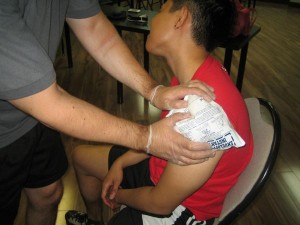Basic Life Support and training curricula

Basic Life Support guidelines were created after research and meetings were conducted by cardiac-health focused organizations in the United States. The guidelines are used in all our basic classes, focused on core skills and techniques used to manage cardiovascular and respiratory emergencies. We have three basic courses that are based on the BLS guidelines and two advanced courses based on the Advanced Life Support guidelines.
There are several parts of the BLS guideline from the AHA, the first focused on the order of steps taken when giving CPR and the second focused on specific skills and techniques related to cardiovascular emergency management.
Acute coronary syndrome
ACS or acute coronary syndrome was responsible for 1 out of 5 hospital admissions in the US in 2005. A heart condition was responsible for 1 out of 6 deaths in 2006. The AHA actually predicts 785,000 new coronary attacks in a year and almost half a million recurrent coronary attacks during the same period. One of the most important things we teach our trainees is to recognize the signs and symptoms of a cardiac problem, even before a heart attack occurs. Prevention is the key to lowering the statistics for morbidity and mortality due to heart problems in the US.
CPR and first aid training

Learning how to give CPR is not the only thing we teach our students. We teach them how to perform basic first aid, for a variety emergency situations and injuries.
- Basic Life Support (for HCPs) – 4.5 hours; one and two-person rescue
- Heartsaver – 4 hours; one-person rescue for the public
- Heartsaver C – 4.5 hours; one-person rescue for HCPs
- Pediatric Advanced Life Support – 14 hours; pediatric medical management
- Advanced Cardiac Life Support – 16 hours; adult medical management
(1) Chest compressions is the most important CPR skill we teach in our basic and advanced courses. Compressions alone, when given correctly and timely, can improve survival rates of people who experience heart attacks. Remember to give chest compressions hard and fast, with at least a rate of 100 a minute.
(2) Ventilations are the important as well, but not as important as chest compressions (if the victim is breathing normally or regularly during cardiac arrest). However, if the victim is experiencing irregular or absent respiration, ventilations are important in oxygenating the blood that circulates through the body with every compression.
(3) Defibrillation is used when the victim is experiencing severe arrhythmias, but can only be performed if an automated external defibrillator (AED) is available. This is why AEDs are commonly only performed by EMTs (emergency medical technicians).
Certification and renewal
We award certificates to all trainees who are able to complete their enrolled course with full attendance and passing grades on the pre- and post-tests. Post-tests are given at the end of each program, in both basic and advanced training.